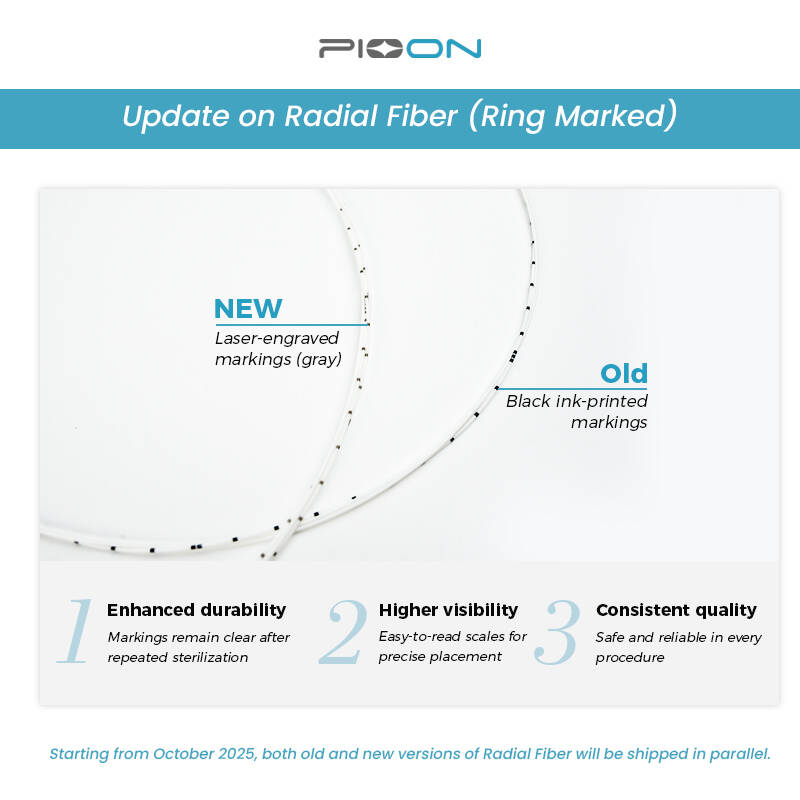
Precise Markings, Enhanced Safety — New Laser-Marked Radial Fiber
This is a very significant product upgrade. Upgrading the calibration marks on a radial fiber used in Endovenous Laser Treatment (EVLT) from traditional inkjet printing to laser marking is more than just a change in manufacturing technique; it is a comprehensive enhancement of the product's safety, precision, and reliability.
The core advantages of this upgrade, with a special focus on the clinical benefits in practice
1. Significantly Improved Biocompatibility and Patient Safety
This is the most critical advantage of this upgrade.
Old Technology (Inkjet Marking):
Risk of Foreign Particle Shedding: Inkjet printing is an additive process that applies a layer of ink onto the fiber's surface. During an EVLT procedure, the fiber is inserted into a blood vessel through an introducer sheath and comes into direct contact with blood and bodily fluids. Throughout this process, the ink markings can potentially flake, chip, or dissolve due to friction or immersion. These microscopic ink particles, if shed into the bloodstream, become foreign bodies that could trigger an inflammatory response, allergic reactions, or even pose a potential risk of microthrombus formation.
Concerns over Chemical Composition: Although medical-grade inks are required to be non-toxic, their chemical components are not part of the native fiber material. Their long-term biocompatibility requires extremely rigorous and complex validation.
New Technology (Laser Marking):
Zero Additives, No Shedding: Laser marking utilizes a high-energy laser beam to directly alter the physical or chemical properties of the fiber's coating material (e.g., through ablation, carbonization, or color change), creating a permanent mark. This process adds no foreign substances; the mark becomes an integral part of the material itself.
Fundamentally Eliminates Risk: By having no ink, the risk of marking material detaching and entering the bloodstream is completely eliminated at its source. This vastly improves the safety of the procedure, which is a crucial quality leap for any interventional medical device.
2. Ensured Procedural Accuracy and Reliability
The success of an EVLT procedure heavily relies on the surgeon's precise control of laser energy delivery, which includes withdrawing the fiber at a steady and accurate pace.
Old Technology (Inkjet Marking):
Fading or Disappearing Marks: During insertion and withdrawal, the fiber experiences constant friction against the introducer sheath and the vessel wall. Immersion in blood and saline can also cause the ink marks to smudge, fade, or even rub off entirely. If the centimeter markings that the surgeon relies on become illegible, it directly compromises their ability to judge the pullback speed. This can lead to over-treatment (damaging surrounding tissue) or under-treatment (leading to recurrence) of certain vein segments.
Poor Legibility: The contrast and sharpness of ink marks are often limited, and their visibility can decrease significantly when smeared with blood.
New Technology (Laser Marking):
Permanent and Indelible: Laser marks are etched into the surface of the material, making them extremely resistant to abrasion. The markings will remain sharp and clear throughout the entire procedure, regardless of friction or fluid exposure.
Guarantees Precise Pullback: This provides the surgeon with an absolutely reliable visual reference. The ability to clearly see the calibration marks at all times allows for a textbook-perfect, controlled pullback (typically 1 mm/second). This ensures that laser energy is delivered uniformly along the entire length of the diseased vein, which is key to achieving optimal results and minimizing complications.
3. Superior Durability and Resistance to Sterilization
Medical devices must undergo strict sterilization before they can be packaged and sold.
Old Technology (Inkjet Marking):
Marks Can Be Damaged by Sterilization: Common sterilization methods, such as Ethylene Oxide (EO) gas or gamma irradiation, can react with the chemical components of the ink. This can cause the marks to discolor, become brittle, or lose adhesion. This not only affects the clarity of the markings but also increases the risk of them flaking off during use.
Complex Process Validation: It requires additional, complex validation to ensure that the specific ink used can withstand the chosen sterilization method without degrading.
New Technology (Laser Marking):
Chemically Stable and Unaffected: As the laser mark is part of the fiber coating itself, its properties are identical to the surrounding material. It has excellent resistance to all standard medical sterilization methods (e.g., EO, gamma, plasma). The sterilization process has no negative impact on the mark's clarity, contrast, or integrity, ensuring a high-quality product in its sterile state.
4. Enhanced Clarity
High Contrast and High Resolution: Lasers can produce extremely fine, crisp, and high-contrast marks. This makes it easier and faster for the surgeon to read the measurements under operating room lighting, reducing eye strain and the potential for misinterpretation.
Summary
In conclusion, upgrading the marking on EVLT radial fibers from inkjet printing to laser marking is a transformative technological advancement. The benefits are far more profound than simply being "more durable":
From a Safety Perspective: It eliminates the primary risk of ink particles entering the patient's body, elevating patient safety to a new standard.
From a Precision Perspective: It guarantees absolute clarity and reliability of the measurement marks during surgery, providing a solid foundation for flawless surgical technique, which is directly linked to the clinical outcome.
From a Reliability Perspective: It ensures the product maintains its functional integrity and quality even after undergoing rigorous sterilization processes.
For the surgeon, this means having a safer, more precise, and more trustworthy tool. For the patient, it means a lower-risk procedure and a better therapeutic outcome. This is a classic example of how a manufacturing process upgrade delivers significant and tangible clinical value.
